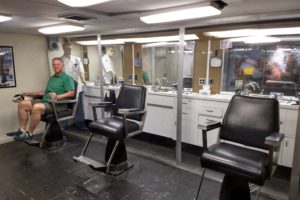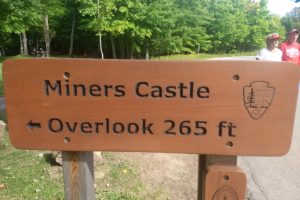One of our observations of North Dakota is that the people who live here love their state and want to show it off. When Barney was first investigating what to do in this area, he came across the Wee’l Turtle in the town of Dunseith, which is also the closest town to the International Peace Gardens.


The world’s largest man-made turtle was put together in 1982 by welding together over 2,000 steel wheel rims. This project was done by George Gottbreht, owner of Dale’s Thrifty Barn that stands next door.
The metal head alone weighs over a ton and is mounted on a pivot so folks who have been working out can bob it up and down. Didn’t work for us.

yummy ice cream
Nearby is the Pride Dairy that was established in the 1930s as a place for farmers to bring their extra cream. In the 1950s, the original Dairy Dipper opened up to sell ice cream treats, but it only lasted about 10 years. In 2011, Dairy Dipper II opened and the Luncheonette was added 2 years later to serve soup and sandwiches during lunch time. Ice cream is served all day, of course.


They serve 22 flavors of ice cream year round with a seasonal flavor offered in December. The dairy also produces caramels and topping, honey, at least 32 varieties of cheese, and 3 types of cheese curds. Syrups, toppings, and private label coffee roasted in ND round out their offerings.


Tommy Turtle on a snowmobile

Tourists can see Tommy Turtle from Hwy. 5 and know it’s time to turn north to get to the Turtle Mountains. Tommy’s home is at a town RV park with full-hookups that’s first-come, first-serve. Something to remember if we come back.
highways through the mountains
Two major highways run east-west through the Turtle Mountains. Hwy. 5 is in the southern part of the mountain (hill) range, and the Turtle Mountains Scenic Byway along Hwy. 43 is further north. This 53-mile stretch of road is one of the most beautiful in the state, especially since we came from the east where it was flat, flat, flat and the only trees were those planted as windbreaks around farm homes and buildings.
After ascending to the top of the mountains, the road descends into the foothills, giving us a spectacular view of the prairie. Many of the state’s major tourism sites are located along this scenic byway.
ski area


Annie’s House visitor’s center (on the left) is a 11,500 sq. ft. facility providing comfortable seating, warm food, and free Wi-Fi. It also houses the rental shop, ski patrol, kitchen, and bathrooms.



ND’s Stonehenge
Close to the ski area is Mystical Horizons, a scaled-down stone structure that’s called a 21st century version of Stonehedge and some other items that explain astronomical phenomena and principles.

This astronomical-themed site contains a working solar calendar built from granite pillars that was intended to represent a 21st-century Stonehenge, a sun dial, and a north star sighting tube.


He was a visionary, aerospace designer, engineer, pilot (WWII), artist, author, and inventor. Though Olson died of cancer in 2001 before construction began, the community raised funds to make his dream a reality, along with partnerships that included North Dakota’s Forest Service and Department of Transportation and the city of Bottineau where Tommy Turtle welcomes visitors to Turtle Mountains. Mystical Horizons opened on October 21, 2005.

“Just as the rise and set cycle of the sun gives us our concept of the day and the phases of the moon our month, a solar calendar gives us our seasons and year . . . This solar calendar marks the end of a season and the beginning of another.”

Since you can read this sign so well if you want all the details, I’ll summarize what I learned for people like me who want just the highlights in everyday words.
A solstice happens twice a year when the sun’s position in the sky, as viewed from Earth, reaches its northernmost or southernmost points. The name comes from Latin words sol (sun) and sistere (to stand still), because it seems like the sun comes to a stop before it reverses direction.
An equinox also happens twice a year, when the earth’s axis is tilted either away from or toward the sun when the center of the sun is along the same plane as the earth’s equator. The name comes from the Latin words aequus (equal) and nox (night), because at these 2 times of the year night and day have almost the same amount of hours.
Amazing the science we can learn as we travel around the nation.



Wish we could have been here for one of these events, but the parking lot is probably packed 4 times a year.

sundial
A sundial works as a clock by measuring time by the position of the sun as it casts a shadow from its style (rod) onto a surface marked with lines indicating the hours of the day.

This sundial tells the correct time of the day during Daylight Savings Time from spring through fall.

All sundials must be aligned with the axis of the earth’s rotation to tell the correct time. Wonder how this happens?
According to Wikipedia, The earliest sundials from archaeological records are shadow clocks (1500 BC) from ancient Egyptians’ and Babylonians’ astronomy. Humans were probably were telling time from shadow-lengths at an even earlier date, but we don’t have records for this. In roughly 700 BC, the Old Testament describes a sundial—the “dial of Ahaz” that’s mentioned in Isaiah 38.8 and 2 Kings 20:11. They were pretty smart and observant back then!
finding the North Star




center of North America



The monument or cairn (a stack of stones) was built in August 1932. It’s in the shape of a pyramid that’s 21 feet high, 6 feet wide at its base, and set on a heart-shaped foundation. Originally it was built across the highway a little northwest of here by 2 local men who got help from local Boy Scouts and other young men in the community. The structure is built with native stone.
In July 1971, the structure was moved to this location when Hwy. 2 was made into a 4-lane road.
time to leave
So many other places to visit are in Turtle Mountains, but many of them were already closed for the season or closed because of Covid-19. After a couple of nights at the campground at International Peace Gardens, it was time to travel westward again.




